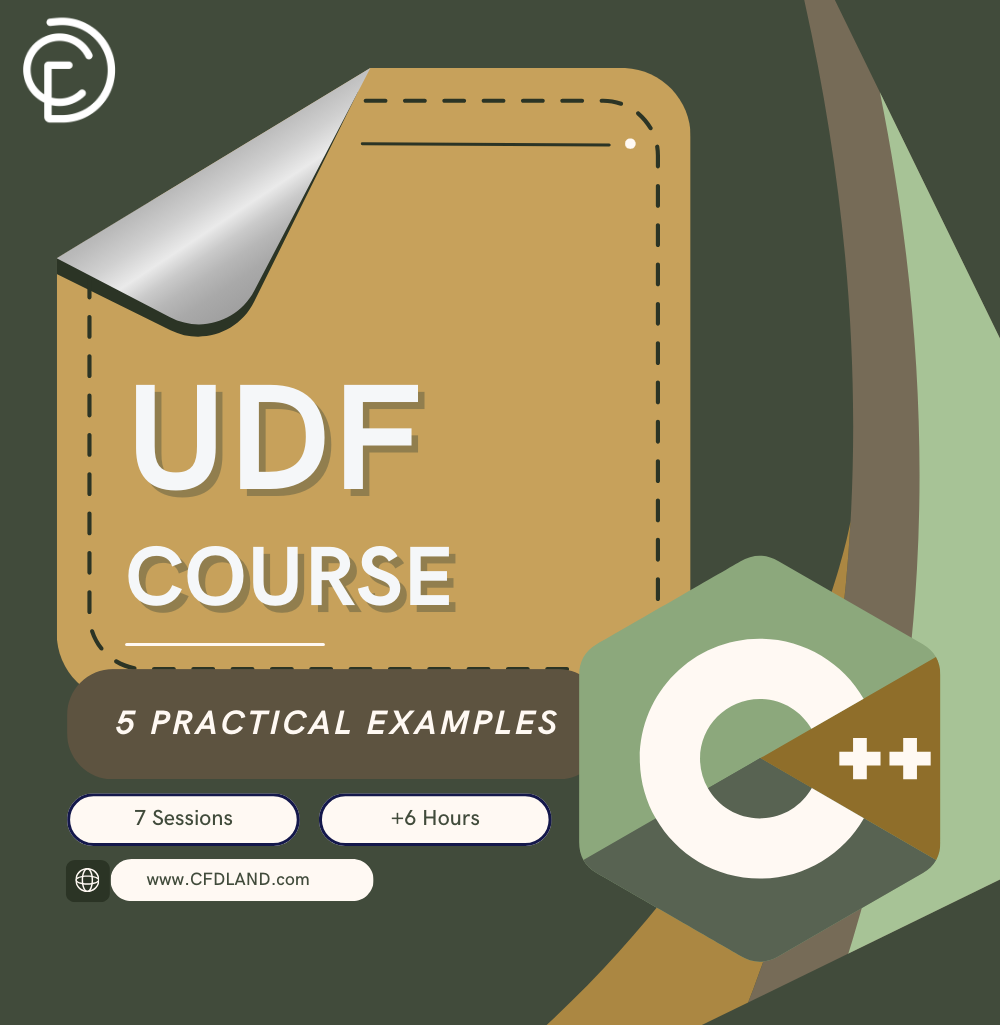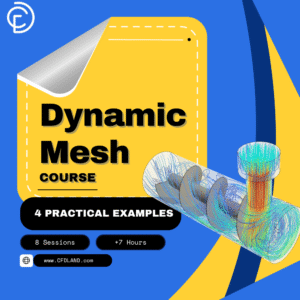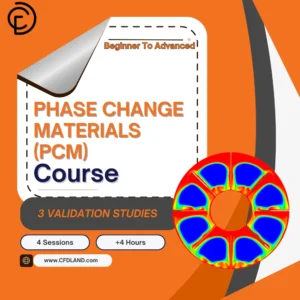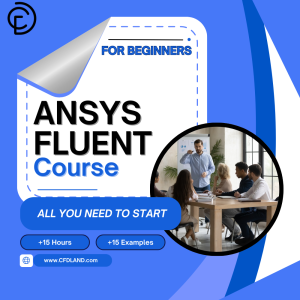UDF ANSYS Fluent Course: Comprehensive Programming & Tutorial
Course Summary: Master UDF Programming in ANSYS Fluent
Welcome to the most comprehensive UDF course for ANSYS Fluent available online! This step-by-step tutorial series teaches you how to write UDFs in ANSYS Fluent from the ground up. Whether you’re a beginner wondering what is a UDF in ANSYS or an experienced engineer looking to create custom boundary conditions in CFD, this course covers everything you need.
Our ANSYS Fluent UDF tutorial takes you through the complete workflow – from basic C programming for CFD to advanced UDF programming techniques. Each session includes practical UDF examples with detailed explanations and complete simulation files. You’ll learn to create time-dependent boundary conditions, implement custom heat sources, define variable material properties, and much more using Fluent macros.
No prior UDF experience needed! We guide you from setup to execution with step-by-step UDF implementation for real engineering problems. By the end, you’ll confidently compile UDFs in ANSYS and customize your simulations far beyond Fluent’s standard capabilities.
€1,150.00 Original price was: €1,150.00.€177.00Current price is: €177.00.
Out of stock
Course details
Course Type : Offline
Course Duration : +6 Hours
Syllabus : 7 Sessions
What You'll Learn In UDF Course
- Master UDF development for ANSYS Fluent - Learn the complete workflow from writing to debugging user-defined functions in ANSYS Fluent
- Essential C programming skills for CFD applications - Gain the exact programming knowledge needed for creating powerful ANSYS Fluent UDF examples
- Apply Fluent macros effectively (DEFINE_PROFILE, DEFINE_SOURCE, DEFINE_PROPERTY) - Understand when and how to use each type of UDF macro in ANSYS Fluent
- Complete simulation workflow integration - From geometry creation through post-processing with UDF implementation
Syllabus for UDF Course In ANSYS Fluent
Objectives: Learn the fundamentals of what is a UDF in ANSYS Fluent and why they’re essential for advanced CFD simulations.
Key Concepts:
- Basic concepts of user-defined functions in ANSYS
- Understanding the Fluent solver architecture
- Complete UDF workflow in Fluent (write → compile → hook → run)
- Differences between interpreted vs compiled UDFs
- Required header files and setup for ANSYS UDF programming
- Using the Fluent GUI for how to compile UDF in ANSYS
- Development environment setup (Visual Studio or GCC)
Objective: Master the essential C programming for CFD concepts needed specifically for UDF ANSYS Fluent development.
Key Concepts:
- Important data types for ANSYS Fluent programming
- Operators and expressions in C for UDFs
- Control structures (if, else, for, while) for flow control
- Functions and macros for effective code organization
- Arrays and pointers (basic introduction)
- Debugging techniques using printf and Message() functions
Objective: Dive into the specialized ANSYS Fluent macros that form the backbone of any UDF programming tutorial:
Key Concepts:
- Macro structure and syntax (DEFINE_*)
- Detailed coverage of DEFINE_PROFILE UDF in Fluent
- Working with DEFINE_SOURCE UDF examples
- Understanding DEFINE_PROPERTY for material properties
- Using DEFINE_ADJUST for custom calculations
- Accessing cell/thread data and simulation variables
- Tips on selecting the right macro for different problems
Objective: Apply your knowledge to create your first practical UDF for pulsatile flow.
Key Concepts:
- Step-by-step UDF implementation for sinusoidal velocity profiles
- Writing a DEFINE_PROFILE UDF using CURRENT_TIME
- Techniques for hooking and testing your custom boundary conditions
- Monitoring velocity profiles and transient behavior
- Real-world applications for time-dependent boundary condition UDFs
Objective: Learn to implement custom heat source UDF for thermal simulations.
Key Concepts:
- Creating a DEFINE_SOURCE UDF example for volumetric heat generation
- Using cell temperature (C_T) and position data
- Implementing temperature-dependent heat source expressions
- Hooking UDFs into fluid zones correctly
- Verification techniques using contour plots and comparisons
Objective: Master techniques to model temperature-dependent material properties.
Key Concepts:
- Writing an effective DEFINE_PROPERTY UDF
- Defining non-linear property functions for realistic simulations
- Accessing temperature and other scalar fields in your simulations
- Properly hooking into Fluent’s material properties panel
- Example case: Thermal conductivity varying with temperature
Objective: Learn advanced techniques for boundary condition switching UDF:
Key Concepts:
- Creating sophisticated DEFINE_PROFILE or DEFINE_ADJUST UDFs
- Implementing logic to change boundary conditions based on runtime conditions
- Real-world scenario implementation with switching between hot/cold inlets
- Using global/static variables effectively to track simulation events
- Advanced execution control for complex simulations
Why Choose CFDLAND UDF ANSYS Fluent Course?
-
Complete simulation workflow – Each example starts from geometry creation and goes through mesh generation, UDF writing, solving, and post-processing
-
Practical application focus – Learn to solve real engineering problems, not just theoretical concepts
-
Full simulation files included – Receive complete UDF examples for ANSYS Fluent for each session
-
Suitable for all levels – Designed for beginners, but includes advanced content for experienced users
-
Beginner-friendly approach – Simple explanations of complex concepts with step-by-step UDF tutorials
-
Lifetime access – Return to the material whenever you need a refresher on how to implement UDF in Fluent
Frequently Asked Questions
-
Do I need prior programming experience? No! We teach C programming basics for ANSYS UDF from scratch. The course is designed for engineers, not programmers.
-
How detailed are the example sessions? Each example is comprehensive – starting from geometry creation through mesh generation, writing the UDF, compilation, solving, and post-processing. Nothing is skipped!
-
Is this course suitable for beginners? Absolutely! We designed this ANSYS Fluent UDF course specifically for beginners but include advanced content that benefits intermediate and expert users too.
-
Will this work with my version of ANSYS Fluent? Yes, the UDF programming techniques taught work with all recent versions of ANSYS Fluent (16.0 through the latest release).
-
What files will I receive with this course? You’ll receive complete UDF files for each session along with all sessions videos.
-
How long do I have access to the course? Once purchased, you have lifetime access to all course materials, including any future updates to the UDF tutorial ANSYS Fluent content.
Ready to master User-Defined Functions in ANSYS Fluent? Enroll now and transform your CFD simulation capabilities!
This course is ideal for engineers, researchers, and professionals seeking to deepen their understanding of PCM technology and its real-world applications. Whether you’re involved in energy management, thermal engineering, or product design, this course provides valuable insights and practical skills to drive innovation in your field.
- In-depth understanding of Phase Change Materials and their thermodynamic properties
- Proficiency in simulating and analyzing PCM systems using industry-standard tools
- Practical insights into applying PCM technology for heat transfer enhancement, energy storage, and renewable energy solutions
Related products
-
↓ 86%
Out of stock
TrainingCourseDynamic Mesh Training Course in ANSYS Fluent
Rated 0 out of 5€1,350.00Original price was: €1,350.00.€185.00Current price is: €185.00. Read more -
TrainingCourse
Phase Change Materials (PCMs) Course – ANSYS Fluent
Rated 0 out of 5€640.00Original price was: €640.00.€299.00Current price is: €299.00. Add to cart -
TrainingCourse
ANSYS FLUENT COURSE For BEGINNERS
Rated 5.00 out of 5€1,500.00Original price was: €1,500.00.€299.00Current price is: €299.00. Add to cart










Reviews
There are no reviews yet.